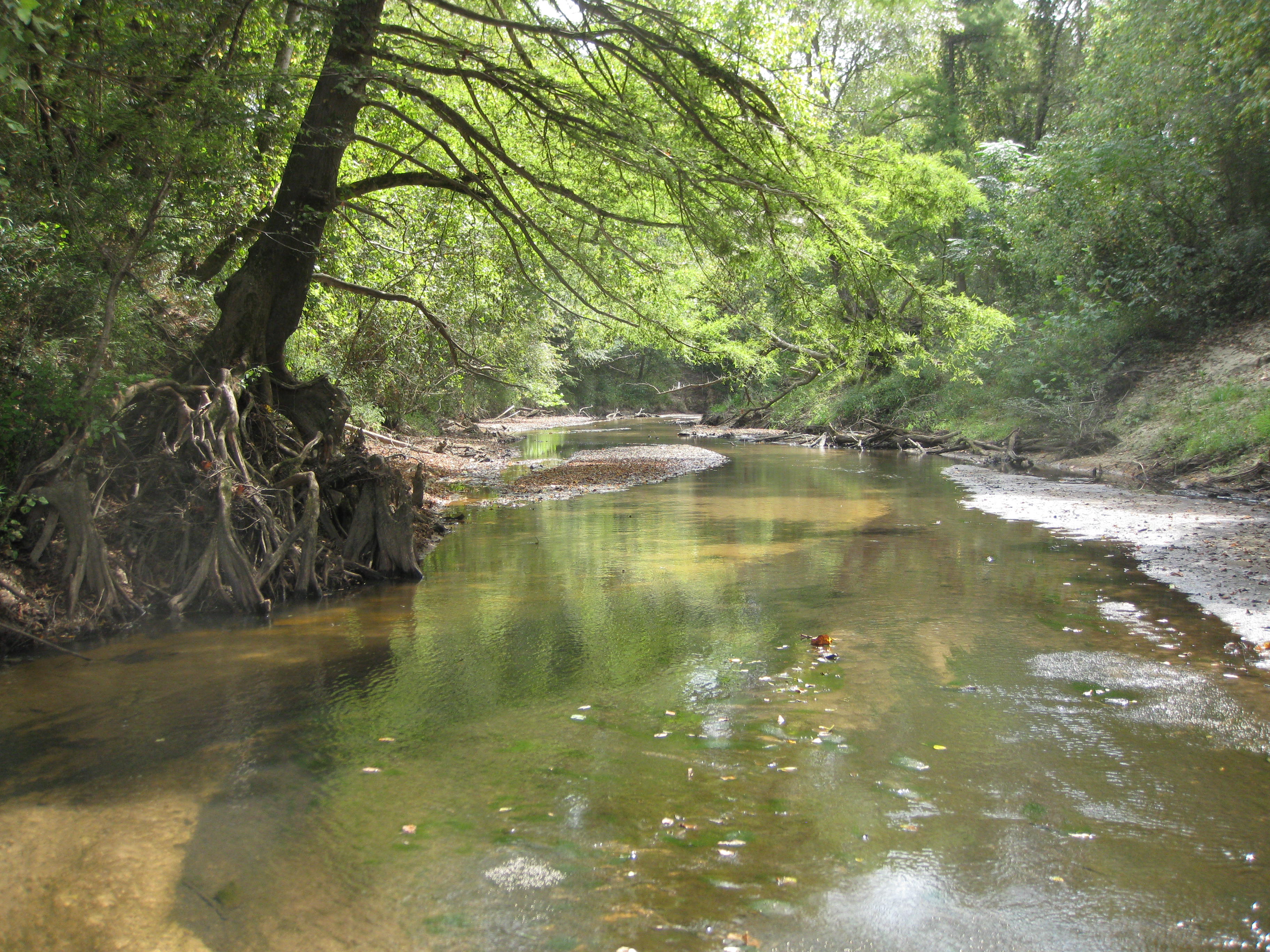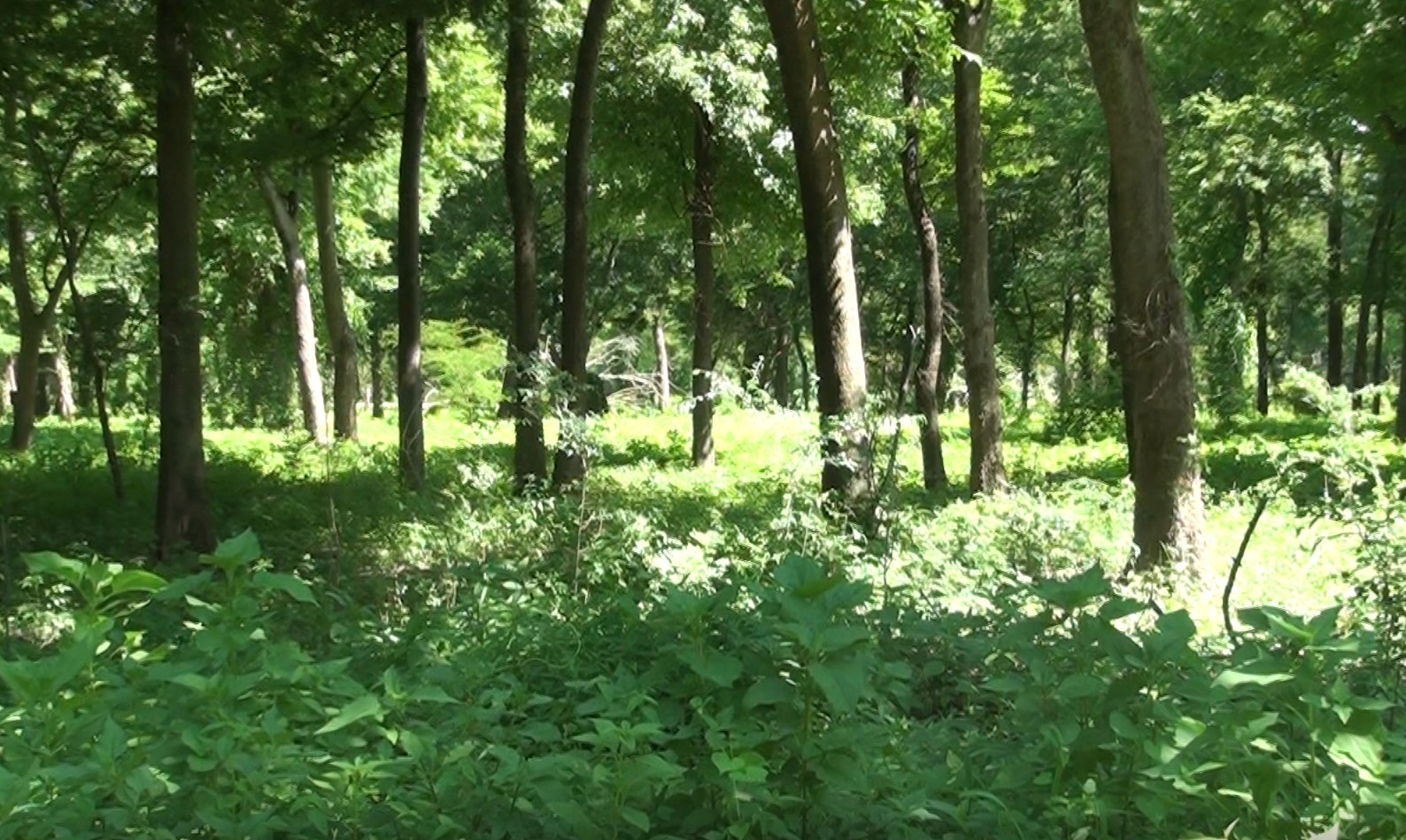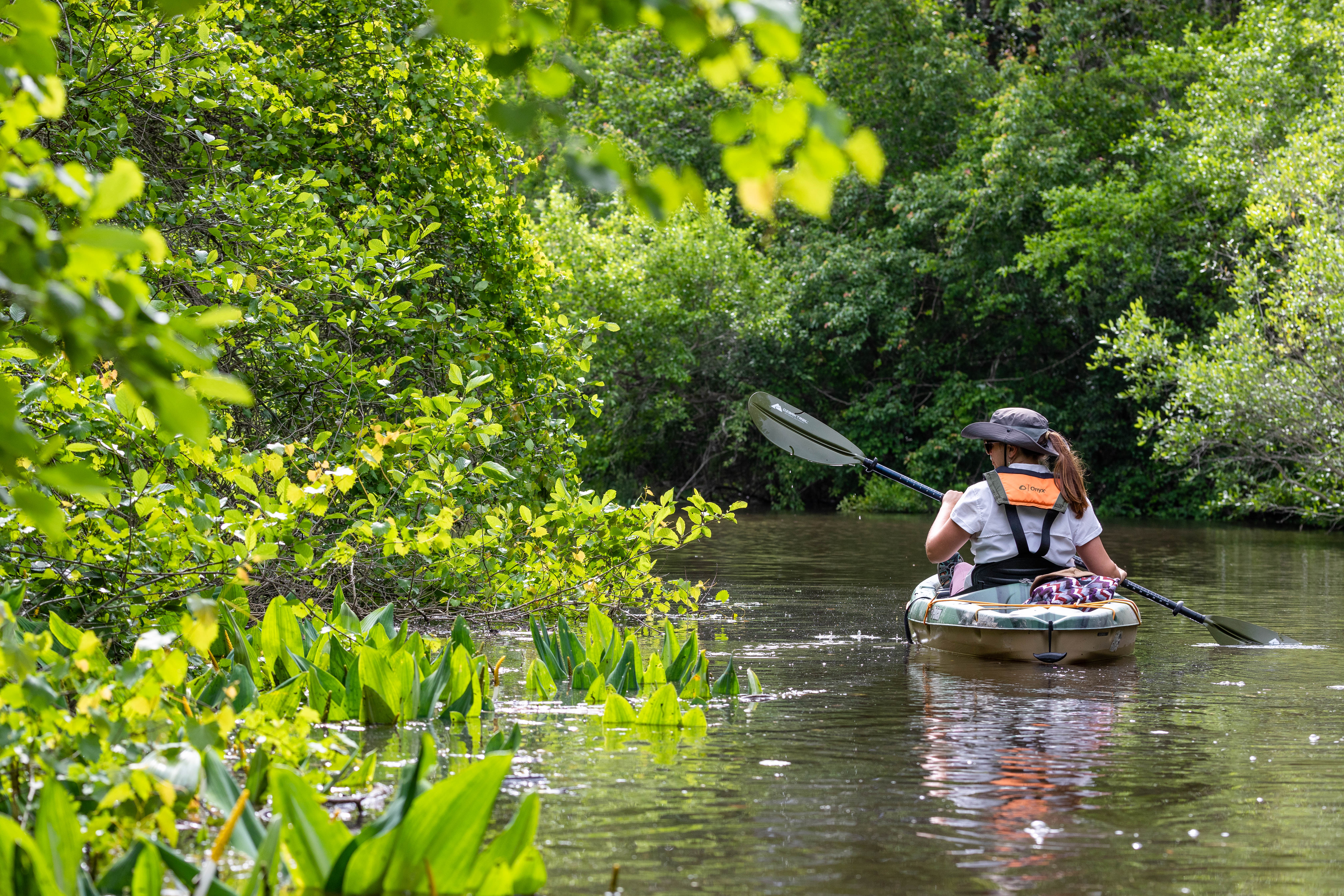
If you have questions about purchasing a license call 1-800-5GO-HUNT.
The Scenic Streams Stewardship Program was designed to promote voluntary private conservation efforts along Mississippi's unique and outstanding rivers and streams.
 As we enter a new century, the landscape of Mississippi will change. People will continue to move out of cities into rural areas with road building projects expanding to connect communities and accommodate this development. The agriculture and forestry industries will continue to provide food, building materials and paper and pulp products for our society. People and industry will make expanding demands on water resources for services such as sewage treatment, surface drainage, and water for industrial processes.
As we enter a new century, the landscape of Mississippi will change. People will continue to move out of cities into rural areas with road building projects expanding to connect communities and accommodate this development. The agriculture and forestry industries will continue to provide food, building materials and paper and pulp products for our society. People and industry will make expanding demands on water resources for services such as sewage treatment, surface drainage, and water for industrial processes.
Our rivers and streams will flow through this increasingly populated and complex landscape. When you consider the multiple uses that we presently demand of our rivers and streams, increased demands in the future are a cause for concern. Streams accommodate our various human activities, but at the same time they support a rich variety of fish, aquatic animals, and plants. Streams, their flood plains, and hardwood bottom-lands provide essential wildlife habitat for deer, turkeys, rabbits, squirrels, most of our migratory and native songbirds, and countless other varieties of wildlife.
People have long felt a strong connection to streams and rivers. They run through our history, our literature and our personal experiences. Whether it is the scenery, the sounds, the cool water on a summer day, the pull of a fish in the current, or the gliding of a canoe, streams and rivers provide us with diverse pleasures. Their value to us is not easily measured, but it is great. To maintain this value, streams need the consideration and help of landowners and others.
 In the Act that creates the Scenic Streams Stewardship Program, the drafters wrote that there is a necessity for a "rational balance between the use of these streams and the conservation of the natural beauty along these streams". Conservation is possible through the concern and effort of landowners of property adjoining rivers and streams.
In the Act that creates the Scenic Streams Stewardship Program, the drafters wrote that there is a necessity for a "rational balance between the use of these streams and the conservation of the natural beauty along these streams". Conservation is possible through the concern and effort of landowners of property adjoining rivers and streams.
Landowners along streams need to make their land produce income for them just like landowners without streams. Their financial obligations begin with annual taxes to the county, and involve mortgages and loan payments. Stream-side landowners are different from other landowners because their activities along the stream can directly affect it for better or worse.
For these select few people, there is tremendous opportunity to be good stewards of the water, land, and wildlife along the stream. Stewardship is defined by Webster's as "the careful responsible management of something entrusted to one". A steward is a conservator.
The Scenic Streams Stewardship Program asks that landowners consider voluntarily using Best Management Practices (BMPs) along streams and leaving a buffer zone of trees and vegetation along the banks. A stream buffer zone or Streamside Management Zone (SMZ) of an appropriate size and width will keep erosion to a minimum, and will keep stream banks stable. The width of the buffer zone is left strictly up to the landowner. Soil specialists or foresters can recommend appropriate widths based on slope, and soil characteristics.
 The benefits of keeping stream banks intact through the use of BMPs are many. Property values remain strong, soil and nutrients stay in place, and the stream avoids degradation from silt, caving banks, and erosion. Also, swimming holes stay deep, and a canopy of trees helps keep water temperatures cool.
The benefits of keeping stream banks intact through the use of BMPs are many. Property values remain strong, soil and nutrients stay in place, and the stream avoids degradation from silt, caving banks, and erosion. Also, swimming holes stay deep, and a canopy of trees helps keep water temperatures cool.
There is a balance for landowners between leaving uncut buffer zones and using their land and timber resources fully. Trees left standing translate to foregone profits in a timber sale. The legislature made the Stream Program completely voluntary so nobody would feel regulated into leaving uncut trees.
A landowner participating in the Scenic Streams Stewardship Program will become eligible for any tax incentives that may come into existence. The Department of Wildlife, Fisheries, and Parks recognizes that tax credits or other financial incentives will greatly aid this stream buffer program.
Recently enacted state tax credits for re-planting trees (Reforestation Tax Credit) will help those who replant along streambanks. Tax credits for fish and wildlife habitat improvement activities along streams are desired at this time by the Department and will be proposed to the Legislature. Proposed creditable activities include leaving buffer zones along streams. Federal tax law presently provides income tax deductions and estate tax reductions for qualified conservation donations such as conservation easements.
This Program considers one stream at a time, and is built at the community level. If a stream is evaluated and found eligible, an Advisory Council with a landowner majority is assembled from the communities near the stream. If strong public support for nomination is shown in the community, and if this is reflected by comments at the public meeting, a bill of nomination is submitted to the legislature. If local support is lacking, the stream won't be nominated. This is a joint decision of the Advisory Council and the Department.
This program gives interested landowners a way to do things that will have a positive effect on their streams without mandatory regulations.
Following passage by Congress of the National Wild and Scenic Rivers Act in 1968, Mississippi's first attempt at a streams bill was in 1969. After 6 failed attempts at a regulatory streams act, the project was abandoned in 1978. If nothing else, it was clear that a program that was mandatory or regulatory would not work in Mississippi.
Twenty years later came a renewed effort to have a streams program in Mississippi without regulation. This effort came under the leadership of the late Richard L. "Dick" Livingston, chairman of the House Game and Fish Committee, and William Y. Quisenberry, of The Department of Wildlife, Fisheries, and Parks--a longtime key player in state land conservation . The Mississippi Scenic Stream Stewardship Act was passed in the in the 1999 Legislative Session and was signed by the Governor on March 16, 1999. This legislation created the Scenic Streams Stewardship Program, which began August 9, 1999.
 The goal of the program is to encourage voluntary private conservation efforts by riparian (stream-side) landowners. In a non-regulatory framework, landowners will be assisted in voluntary management agreements that seek to maintain scenic values while ensuring their rights to continue customary uses along the stream.
The goal of the program is to encourage voluntary private conservation efforts by riparian (stream-side) landowners. In a non-regulatory framework, landowners will be assisted in voluntary management agreements that seek to maintain scenic values while ensuring their rights to continue customary uses along the stream.
When a stream or river is nominated to the program, a landowner-based stewardship plan will be created for it. Generally, the goal is to maintain good water quality for recreation and fish and wildlife habitat. Achievement of the goal will be through use of Best Management Practices (BMPs), which are water quality improvement practices that will maintain the health of streams by keeping stream banks in good condition and preventing harmful sedimentation.
The program applies to streams that have not been channelized within the past five (5) years and are considered by law to be public waters. Designation as a public waterway depends on the volume of water that flows in the particular section of the stream. The Public Water Statute, Mississippi Code § 51-1-4, provides that for a stream to be a public waterway, the mean annual flow volume must be at least one hundred (100) cubic feet per second (cfs). Small headwater sections of streams do not generally qualify as public waters, and so it is the middle and lower sections of streams that may be qualified for the Scenic Stream Stewardship Program. However, all landowners will be able to participate in tax credits for reforestation, and stream conservation activities.
This program is a creation of the Mississippi State Legislature. If it were to change, the legislature would have to do it. It would be against legislative intent to have a regulatory program. This much can be learned from a reading of the first paragraph of the Act that created the program. The Legislature refused for nearly 30 years to pass regulatory versions of a streams program. The efforts failed six times between 1969 and 1978. In 1999, this voluntary, non-regulatory, landowner outreach program was created and passed into law. The legislature does not want to regulate landowners with a streams program.
In order for the federal government to come in on the heels of a state program, the federal government must have delegated (given) administrative powers to the state over some subject and provided the state with federal guidelines to follow, and the state must have failed to follow them. The Mississippi Department of Wildlife, Fisheries, and Parks has not been delegated any administrative power over streams or waters by the federal government. The Stream Stewardship program is Mississippi law, not federal law, and so there is no basis for the federal government to step in.
No. The important fact is that this does not change public water law, nor does it give anyone more legal rights to float, swim, or use public waters than they had before the program.
This is a landowner outreach program. There is some required public notice about meetings and about the nomination and designation, but most of the interaction with people is aimed at landowners along the stream or river.
The day-to-day work of the program and the vast majority of the correspondence, contact, and transactions will be with landowners. This is not a promotional campaign to open up a river to more use. It is a stream buffer program, with water quality and stream bank stability as its goals. It seeks stability or improvement of fish and wildlife habitat, not increased exploitation of streams. Recreational use will be a natural consequence of having a healthy, scenic stream. Most recreational users of public waters tend to value many of the same scenic qualities as the landowners in the program. Recreational users who litter and break laws will be dealt with by law enforcement officers, as is the present case.
BMPs are voluntary, it is true. The idea of leaving buffer zones along streams is hard to oversell or overemphasize. Farmers have had buffer programs such as CRP and WRP for some time. When compared with farmers, non-agricultural landowners along streams are less likely to receive the message about improving water quality with buffer zones. This program provides a way to directly reach these people.
County and local governments generally do not have the people nor resources to do educational programs that reach out to landowners, and since stream conservation is a statewide issue, it is proper for a statewide resource agency to undertake such a task. This program uniquely fits the expertise of an agency such as the Department of Wildlife, Fisheries, and Parks. Streams provide habitat for the fishery and wildlife resources that the Agency manages. Healthy in-stream and riverbank habitats help sustain fish and both game and non-game wildlife species.
A Stewardship Plan considers a river as a whole and provides a framework in which voluntary, coordinated private conservation efforts can link its different reaches with protective buffer zones. This is a watershed approach to conservation. Also, until now, concerned landowners have not had a way to be part of an organized plan. They may have used BMPs because they felt it would help the river, but they couldn't see how their activities related to what others may have been doing to keep the river or stream healthy. For landowners who had never heard of BMPs, this program is a way to spread the message that riparian landowners have a substantial effect on the river, for better or worse, and that the choices they make matter for the overall condition of the stream.
Unity of purpose and the ability to see how one's efforts relate to similar undertakings up and down a stream make this different from the status quo. This gives direction to concerned riparian landowners and a way to focus their concerns about their stream.
This program does not create another layer of regulation for farmers. The farmers who will have contact with the program are those who have pastures or fields along banks of streams that become eligible for the Scenic Streams Stewardship Program. They will be contacted by the Department by mail when their parcel is found in the county land ownership maps at the tax assessor's office. They will receive notice of public meetings concerning nomination, and will be invited to comment on the inclusion of their stream in the program. Farmers may already be involved in CRP continuous sign-up buffer programs.
If their river is nominated to the program, farmers will be contacted by the Department again about being part of a voluntary Stewardship Plan. They can choose to participate by agreeing to use BMPs bordering the stream, and will be assisted by the Department in implementing this agreement, or they can choose not to participate at all.
The program does not single out farmers but offers the same encouragement and opportunity to them as it does to other landowners.
There are eight steps involved in getting a steam nominated to the program:
A Stewardship Plan is composed of voluntary agreements by landowners to keep buffer zones along their sections of streams by the use of Best Management Practices (BMPs) when they harvest timber or clear along stream banks. BMPs are a set of recommended guidelines for planning and conducting timber harvest operations so that adverse effects from soil disturbance do not harm water quality in nearby streams.
The practices are designed to reduce sediment runoff to a minimum by leaving adequate vegetation in place along the banks of running streams.
BMPs help maintain the scenic values of the stream while ensuring the rights of riparian (stream-side) landowners to continue existing agriculture, forestry, water supply, recreational, commercial and industrial uses, and any other uses identified. This plan is created with the assistance of the State Soil and Water Conservation Commission, and the State Forestry Commission. A landowner is not obligated or required to participate in the plan.
A range of stewardship options will be available to a landowner wishing to participate in the Stewardship Plan. Landowners can take part through non-binding BMP agreements, or through binding grants such as conservation easements. The choice to participate or not is left to the landowner.
The basic option is the non-binding agreement with the Department that the landowner will require Best Management Practices when harvesting timber along stream banks. This means that BMPs will be made a requirement of the timber deed or contact of sale with the timber buyer. BMPs call for leaving an area of uncut trees and vegetation of an appropriate width along the stream bank. Foresters call this a Streamside Management Zone or SMZ. The width of the SMZ will depend on the grade or slope of the land, and on soil type, and other individual characteristics of the land. Leaving uncut trees and vegetation along streams serves the purpose of holding the bank soils, slowing rainwater runoff, and filtering out and trapping sediments and soil before they wash into the stream. This agreement is non-binding and can be canceled with 30 days notice to the Department.
Other stewardship options can include the granting of a conservation easement or right of use to a holder such as: a private nonprofit, charitable or educational corporation, association, or trust, or an appropriate state governmental body. An easement is similar to a right-of-way, or a limited right of use for a certain purpose. A conservation easement is a legal agreement a property owner makes to restrict the type and amount of development that may take place on his or her property. The landowner still owns the land to which the easement applies. The Department of Wildlife, Fisheries, and Parks can be granted easements, or donations of land for conservation purposes along streams.
An example of a significant conservation easement is International Paper Company's agreement to limit disturbance in a 300-foot forested buffer on either side of the Wolf River for 15 miles in Harrison County. The Company negotiated the terms of the easement, and was afforded tax relief. Land donated to the state reverts back to the donating landowner if the land ceases to be used in the program.
Again, participation in the plan is voluntary, and there is no legal obligation to participate in the stewardship plan. A landowner can terminate participation in a non-binding option (the agreement to use BMPs) by giving 30 days notice of his intent to terminate the agreement and withdraw from the program.
Many landowners will probably choose the non-binding agreement to use BMPs when harvesting timber. This kind of participation in the stewardship plan can be terminated easily. The granting of easements and donations of land are not options which may be terminated by 30 days notice. These types of conveyances are governed by Mississippi property law and should only be undertaken after consultation with an attorney. Such legal acts must also be in writing and filed in the public record in the appropriate County Courthouse. There are advantages to donations for the purposes of individual tax and estate planning, and landowners may be interested to know how these can help ease their tax burdens.
The Department of Wildlife, and Fisheries will insure that interested landowners know the difference between non-binding options and other options such as easements and donations. The distinctions among the different kinds of options must be understood by landowners before entering into any Stewardship Plan.
Under present Federal Tax Law, a landowner can use grants of easements or donations of land for tax relief. A qualified conservation contribution under Section 170 (h) of the Internal Revenue Code is a special class of charitable contribution for which an income tax deduction may be taken equal to 30% of Adjusted Gross Income (AGI) for a total of six years or until the value of the or gift is used up. The gift may be of an easement or of a grant in fee simple, but must meet the conservation purposes test, must be perpetual, and must go to a qualified holder or charity.
Estate tax reductions can also be obtained by certain gifts of qualified conservation easements as defined under Section 2031(c) of the Internal Revenue Code, also known as Section 508 of the Taxpayer Relief Act of 1997.
Mississippi passed its own Conservation Easement Act of 1986, which is a statute providing for the grant of easements (see Miss. Code §89-19-1). This statute gives a clear method for granting gifts of land or easements that can qualify the donor for tax relief under federal law.